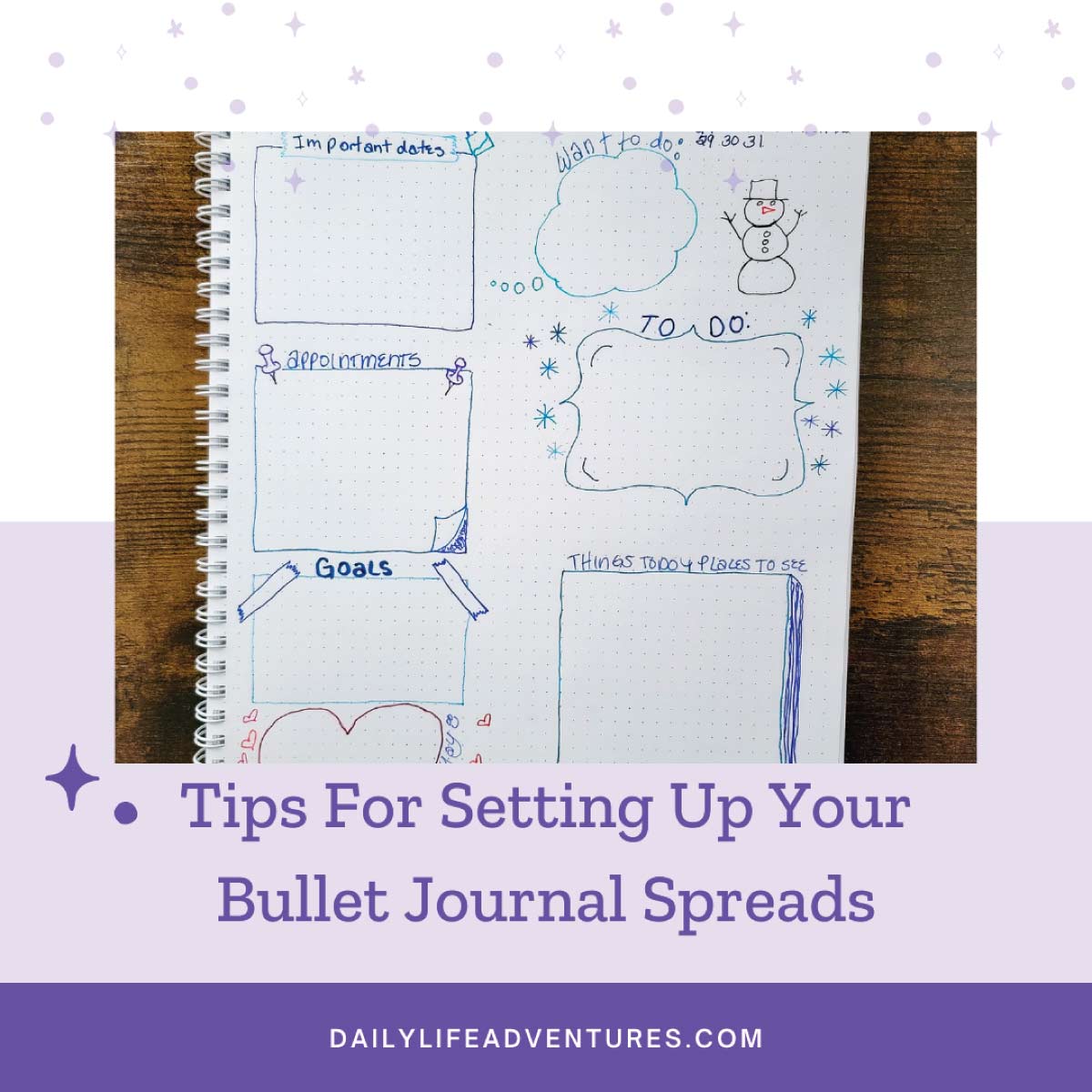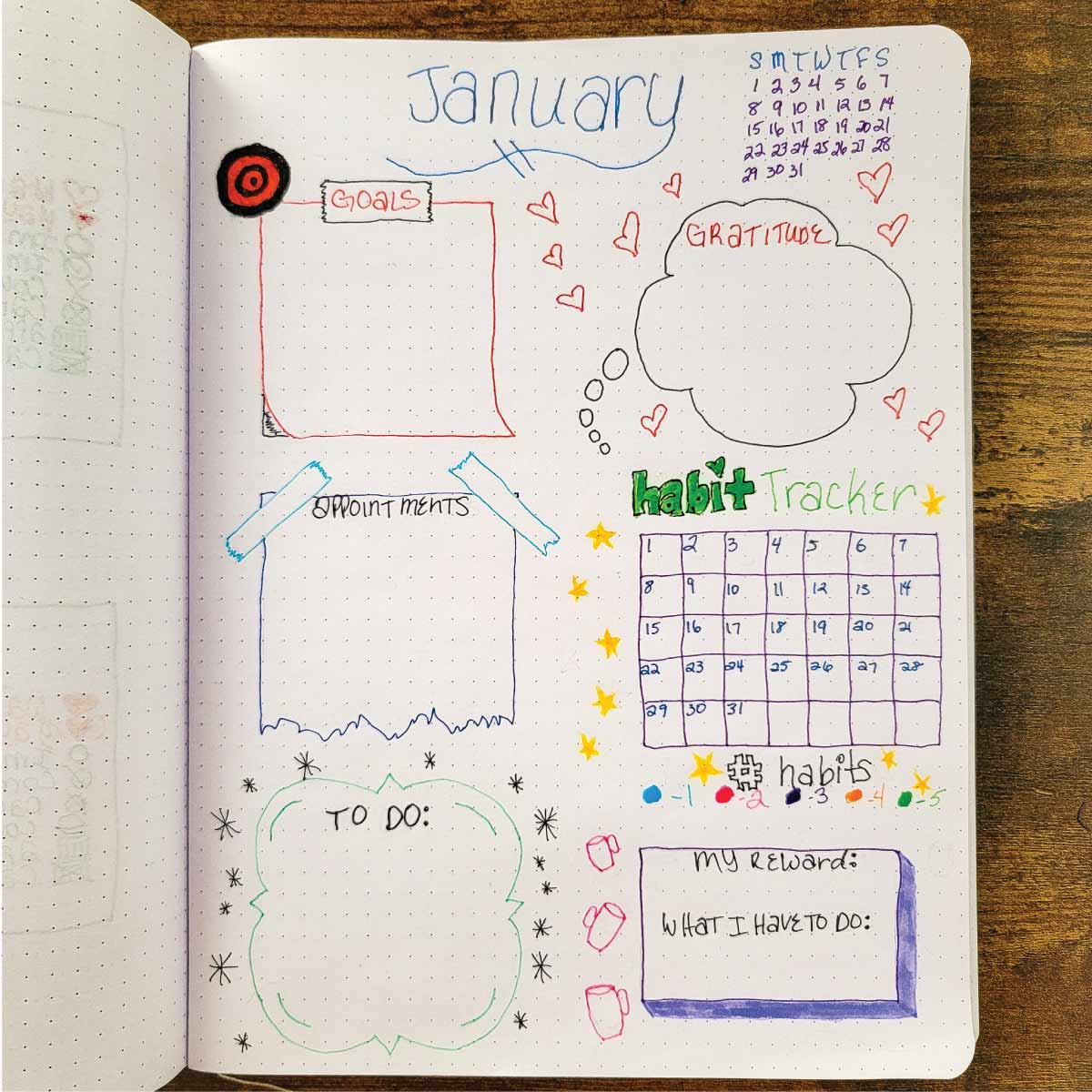Tips for Setting Up Your Bullet Journal Monthly
Do you love making lists, setting goals, and organizing your life? If so, bullet journaling might be the perfect productivity system for you. Using a bullet journal is simple, but it can take some time to find a monthly spread layout you love. Keep reading for some tips on setting up each monthly spread in a way that works for you.

One great thing is that you can completely customize this to make your bullet journal work for you! There is a lot you can do to make it your own whether you want it to be a simple format or a fancy one. You can also get creative and learn how to draw bullet journal banners to add to your spreads too. They are really easy to draw once you get the hang of them.
But how do you set it up you ask? Here are some tips to help you set up your journal in a way that helps you get the most out of it.
Make the Layouts Simple or Complex
If you do a Google search for bullet journaling information, you’ll find tons of results with images of other people’s picture-perfect, heavily decorated journals. If you’re new to bullet journaling, you might wonder, “Do my journal monthly spreads have to look like that too?” The answer: nope.
I remember the first time I looked up about journaling before my daughter convinced me to start. They were all beautiful online but I didn’t start right away because I thought that they had to be this beautifully laid out notebook. The pictures were all pretty but the thought of going from not using one to having to fully decorate it was a bit overwhelming!
Also, it doesn’t have to be perfect. You will see that many monthly spreads from a bullet journal that I share here (unless I digitally created it) are far from perfect. I like to show my imperfect pages to you guys, it is the reality of my life 🙂 I wouldn’t have it any other way!
So do you have to decorate it at all? Nope! A minimalistic monthly layout is just as useful as a layout with tons of doodles and decorative tape. Of course, if you enjoy decorating your journal, go for it! But it’s okay to focus on function over form, too. And if you find yourself especially busy one month, don’t feel bad about using a simpler layout than usual.
Know How You Can Stay Organized
The right monthly layout for your bullet journal will depend on your preferred organization style. Do you like jotting down your events on a calendar, or does a list format work better for you? Do you stay motivated best if you can see your monthly goals at a glance? If you’re not sure, don’t be afraid to experiment a little – you’ll quickly learn what works for you and what doesn’t.
This is something that will be unique to you. I don’t usually add a full calendar to mine (but I will show you examples of calendar spreads.) The reason I do not add it to my journal is because I have a huge dry erase calendar on the wall in front of my desk. So I don’t usually put a full spread monthly calendar in my bullet journal.
I go with a month at a glance similar to this one below (tho I do mix it up a bit!) I don’t usually put a habit tracker on my month at a glance, but some people do and it can be handy. This is just an example to show you a layout idea.

This gives me a glance at everything and I also have a little calendar to see the date quickly if I need to.
Then I break down weekly pages and set it up how I will be most productive. I always have at least one bullet journal brain dump page too so I can get all my thoughts onto paper.
This is your journal, you need to set it up how it will work for you! It will take some playing around with this to get the right layout, but be sure that it helps you stay organized. That is the purpose of the journaling.
Do Some Planning Ahead
Before you start creating your monthly spread layouts, think about which pages you want to include. For example, you might want to have a monthly calendar, a list of to-dos and goals, a habit tracker, or a money tracker. Decide how you want to order these pages.
Try to plan this out carefully because you don’t want to over do it. If you make your bullet journal more like work, you are less likely to stick with it. Start with just what you really want and need, then you can go from there.
To help prevent mistakes, you can lightly sketch your layout in pencil before going over it with a pen, or you can make a mock-up on a separate piece of paper.
I always sketch my monthly spreads in pencil first. This gives me room to change things and I don’t usually draw perfectly the first time. If I showed you my garbage can, you would see all of my eraser shavings. Then I use pens and markers to trace over to give it color.
Give Yourself Plenty of Space

It’s frustrating to run out of space, so give yourself a little more room than you think you need. Don’t try to cram an elaborate layout onto a single page. Your bullet journal is meant to be functional, so utilize all the space you need.
A habit or mood tracker can be put onto one page, but then a brain dump might be better as 2 pages. If you have a lot going on, you may need your weekly spread to go across 2 pages instead of cramming it into 1. Don’t sell yourself short on space here, it is best to have more room then not enough.
Review Your Last Month
If you’ve been bullet journaling for a while, you can get some good ideas by checking out the previous month’s layout. What features did you like? Which ones did you not really use? Is there anything you want to add?
If you are new to it, think about what you would have needed last month. What would have come in handy for you to keep track of? Would a calendar have helped? Or maybe you could have benefited from weekly spreads where you keep track of your schedule. If you find it hard to keep track of the amount of water you are drinking (as an example), be sure to add a water tracker to your journal.
Use Trackers Only When Needed

Lots of people enjoy using trackers, like habit trackers, mood trackers, or exercise trackers, in their bullet journals. Trackers are a great feature – they give you a big-picture overview of how you’re progressing towards your goals. They can be great to add to your monthly layout, but don’t go overboard with them.
If you try to track everything in your life, you’ll get bogged down. Instead, focus on a few key metrics that are important to you. If you find that you want more, add them gradually.
Like for me going through perimenopause, tracking my period was really important to me. It is very inconsistent and when I see the doctor they always ask me how often it comes. I know because I track it. I also track my mood because another fun part of this stage of life is moodiness. Yes please feel bad for my amazing family! I try so hard not to be, but moodiness just sometimes happens before I can stop it.
But I always have a 24 ounce reusable water bottle by my side that I drink all day long so I don’t need to track my water – it would be a chore at that point.
Think about what trackers will help you, don’t just track anything and everything. It will feel like a chore.
Don’t Worry About Mistakes
No matter how careful you are, your bullet journal won’t be perfect, and that’s okay. Don’t let a stray pen line or a messed-up page get you down. Turn the page and try again, or just doodle over the mistake. A few cross-outs won’t make your journal any less useful.
I don’t sweat the little things in life and drawing (or writing) mistakes in your own journal is a little thing not worth sweating over. You are the one using it and you are the one who will be seeing it. If the mistake bothers you, turn the page and do over. I personally still use the page mistakes and all.
Make it Individual
One of the best parts of bullet journaling is that you make it unique to you! From the spreads you add to any doodles (if you choose) to add. It’s all about what you want it to be.
It’s fine to get inspiration from other people’s journals, but feel free to get creative, too! Tweak your favorite layouts and add your own creative spin. Over time, you’ll come up with a monthly layout that’s all your own.
Setting up monthly pages in your bullet journal can be fun, so don’t be intimidated by the task. Whether you prefer a complex layout or a clean, simple one, you’re sure to find a monthly format that works for you.
Do you have any layout ideas you would like to share with us? Let us know in the comments below.
Pin it for later!








